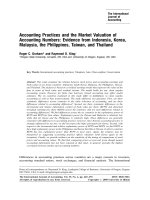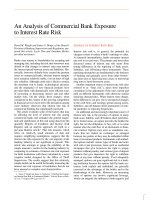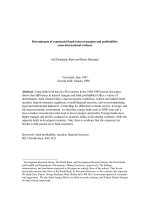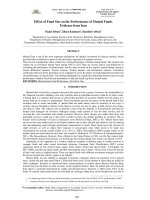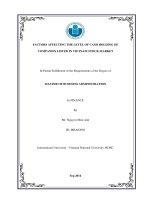Factors affecting the level of depositors’ satisfaction towards the services of commercial bank: Evidence from Vietcombank, Can Tho branch, Vietnam
Bạn đang xem bản rút gọn của tài liệu. Xem và tải ngay bản đầy đủ của tài liệu tại đây (971.91 KB, 16 trang )
Journal of Applied Finance & Banking, vol. 9, no. 6, 2019, 15-30
ISSN: 1792-6580 (print version), 1792-6599(online)
Scientific Press International Limited
Factors affecting the level of depositors’ satisfaction
towards the services of commercial bank: Evidence
from Vietcombank, Can Tho branch, Vietnam
Van-Thep Nguyen1 and Day-Yang Liu 2
Abstract
This study aims to analyze factors affecting the level of depositors’ satisfaction in
Vietcombank, Can Tho brand (Vietnam). The data of this study was collected by a
convenient sampling method from 65 customers who came to the bank for opening
the savings account. By using the Cronbach's Alpha analysis to test the reliability
of the scale, the exploratory factor analysis (EFA) to test the factors that affect
depositors' satisfaction and determine the factors that are relevant for each factor,
the confirmatory factor analysis (CFA), a special case of the structural equation
modeling (SEM) to confirm the theoretical model of a measurement and test the
correlations between the factors whether they are an explicit part of the analysis or
not, and regression analysis to determine the impact factors (including controlling
factors) to the level of depositors' satisfaction, we find a piece of evidence that the
satisfaction of depositors towards the services of Vietcombank, Can Tho branch
(Vietnam) mainly depends on the service quality. Therefore, to attract more
depositors, the bank needs to pay attention to the quality of service to have a better
service for customers.
JEL classification numbers: G15, G21, G28
Keywords: Bank, depositor, satisfaction, service quality
1
Corresponding author. Graduate Institute of Finance, National Taiwan University of Science and
Technology (NTUST), Taiwan.
2
Graduate Institute of Finance, National Taiwan University of Science and Technology (NTUST),
Taiwan.
Article Info: Received: May 13, 2019. Revised: July 10, 2019
Published online: September 10, 2019
16
Van-Thep Nguyen and Day-Yang Liu
1. Introduction
Commercial banks are identified as the backbone of the economy, playing an
important role in regulating the economy, stabilizing the financial market and
managing the economy. In the context of globalization, however, the competition
between local banks as well as domestic and foreign banks becomes stronger. As a
result, banks are now striving to improve service quality, expand their operations
networks, and modernize their banks to attract funds, especially funding from
customers. Capturing the level of depositors' satisfaction, therefore, is always a
matter of concern for banks so that they can meet the needs of existing customers
and attract more potential customers as well. Compared to other banks,
Vietcombank is considered as the largest commercial joint stock bank in Vietnam.
Although it owns a wide network, funding from customers is still difficult due to
compete to other commercial banks in the area. In addition, the operation of the
bank also depends on the area of operation of each branch. Therefore, Vietcombank,
Can Tho branch (Vietnam) also confront many challenges in meeting the needs of
customers. This paper aims to analyze the factors affecting the level of depositors'
satisfaction at Vietcombank, Can Tho branch (Vietnam). The research results are
aimed at helping the bank better meet customers' expectations for the savings
deposit service at the branch. Moreover, research results also help the bank to retain
existing customers and have appropriate strategies to attract potential customers.
The rest of the paper is structured as follows. Section 2 provides a literature review
on the level of depositors’ satisfaction towards the services of commercial banks.
Section 3 describes the data sampling and the methodology, respectively. Section 4
presents the empirical results. Finally, section 5 offers some conclusions.
2. Literature review
Parvin and Hossain (2010) study on the satisfaction of users towards debit card in
some private commercial banks in Bangladesh. The authors find that the higher the
banks improve network service, provide receipt after transactions and solve of
problems promptly, the greater debit card users satisfy.
Chavan and Ahmad (2013) study on factors affecting customer satisfaction in retail
banking in Western Maharashtra in India. Their findings revealed that customer
satisfaction is dependent on eight factors, namely Tangibility, E- fulfillment,
Convenience & Availability, Accuracy, Responsiveness, Empathy, Promptness,
and Personal Assistance.
Parvin et al. (2014) study on the satisfaction level of the individual customers from
deposit management services of different commercial banks of Bangladesh. The
authors employ five group factors named as reliability, responsiveness, assurance,
empathy and tangible with many subfactors. They find a piece of evidence that the
responsiveness, assurance, and tangible have statistically significant effect on
satisfaction level from deposit management services in case of regression between
Factors affecting the level of depositors’ satisfaction towards the services of…
17
satisfaction-specific factors and overall satisfaction from deposit management
services, whereas the only type of bank respondents use and experience of banking
of the respondents have statistically significant effect on the overall satisfaction
level in case of regression between customer-specific factors and overall
satisfaction from deposit management services.
In the same year, Adeniran and Junaidu (2014) study on the satisfaction of
customers towards ATM services in the Nigerian banking sector. The sample in this
study is employed by 100 respondents who are users of the ATM services. By use
of multiple logistic regression analysis, the authors find that the perceived ease of
use, transaction cost, and service security have a significantly positive effect on
ATM services. However, the result also indicates that the relationship between
ATM services and the availability of money is positive but insignificant. In the light
of Adeniran and Junaidu (2014) contributions, Olusanya and Fadiya (2015) have an
empirical study of ATM service quality on customer satisfaction in the United Bank
of Africa. They also find that necessary input to the bank management to increase
customers’ satisfaction through improving ATM service quality
In addition, Mutahar et al. (2017) study on the major factors contributing to
customer intention to use mobile banking services in Yemen. The authors utilize
Structure Equation Modelling (SEM) to determine the levels of association and
interaction between group factors examined. They find that perceived usefulness,
perceived ease of use, self-efficacy and perceived risk are significant predictors of
intention to use mobile banking in the initial stage of adoption.
3. Data sampling and methodology
To apply the research model into reality, the data of this study was collected by a
convenient sampling method by passing the questionnaire to customers who came
to Vietcombank, Can Tho Branch (Vietnam) for opening the savings account.
Analysis methodology in this paper consists of four steps: (1) use the Cronbach's
Alpha analysis to test the reliability of the scale, (2) use the Exploratory Factor
Analysis (EFA) to test the factors that affect depositors' satisfaction and determine
the factors that are relevant for each factor, (3) use the Confirmatory Factor Analysis
(CFA) to confirm the theoretical model of a measurement, and (4) use regression
analysis to determine the impact factors (including controlling factors) to the level
of depositors' satisfaction.
18
Van-Thep Nguyen and Day-Yang Liu
4. Empirical results
4.1
Sample descriptive analysis
The sample consists of 65 savings depositors in Vietcombank, Can Tho branch
(Vietnam). Characteristics of the survey sample included gender, age group, level
of education, occupation and monthly income are shown in Table 1.
Table 1: Descriptive Statistics of the sample
Variables
Count
Percentage (%)
Gender
65
100
- Male
28
43.1
- Female
37
56.9
Age
65
100
18 – 25
10
15.4
- 26 – 30
15
23.1
- 31 – 40
21
32.3
- More than 40
19
29.2
Level of education
65
100
- High school
18
27.7
- Bachelor
24
36.9
- Master
8
12.3
- Other
15
23.1
Occupation
65
100
- Business
15
23.1
- Office worker
16
24.6
- Teacher
4
6.2
- Other
30
46.2
Monthly income
65
100
- Below 10 million VND
35
53.8
- 10 – 15 million VND
19
29.2
- 15 – 20 million VND
6
9.2
- More than 20 million VND
5
7.7
Source: Self-collected data
Descriptive statistics showed that customers are classified by the male and female
ratio of 43.1% and 56.9%, respectively. These ratios show that women often hold
household expenditures, so they often have deposits and transactions with banks.
This is quite suitable for Asian and Vietnamese culture. In particular, the results
show that customers aged 31 to 40 account for the majority with over 32.3% of the
total number of observations because they are people of working age and make
income, so they can desire to save for the future. Data from this study shows that
these depositors are mainly holders of Bachelor’s degree (36.9%), High school
(27.7%), a few with Master’s degree (12.3%), and other (46.2%). This group of the
Factors affecting the level of depositors’ satisfaction towards the services of…
19
customer has jobs in a wide range of occupation such as office workers (24.6%),
business (23.1%), teacher (6.2%) and other such as retired staffs, housewife, etc
(46.2%). In addition, savings customers have an average monthly income of
between 10 million VND and 15 million VND, accounting for 29.2% of the total.
Most of them earn less than 10 million VND (53.8%), the rest of the sample has
income is higher than 15 million (16.9%). The depositing of savings at any bank
depends a lot on the source of information of the bank itself. The results of the
information provided to depositors are shown in Figure 1.
Figure 1 shows that customers who come to open the savings account have many
sources of information about deposit products such as from relatives, bank websites,
bank employees, or other sources of information (television, radio, etc). However,
the source of information they the most approach was from the bank's website
(43.08%), the remaining from relatives accounted for 27.69%, from other sources
accounted for 18.46%, and from bank employees account for 2.6%. This means that
to attract customers to open a savings account depends a lot on the bank's website.
The bank, therefore, should design a website with attractive and full information
about the deposit service as well as promotions.
Figure 1: Do you know Vietcombank through which information source?
Source: Self-collected data
To determine the factors affecting the satisfaction of customers deposited in
Vietcombank, Can Tho branch (Vietnam), the author has conducted a survey of
customers who have come to the bank. Factors affecting the satisfaction of bank
depositors are divided into four groups of factors, with a total of 14 factors, namely
(1) Brand (Vietcombank is a well-known bank; Vietcombank is a reputable bank;
and Vietcombank has operated in the banking industry for a long time), (2)
Distribution Channel (Transaction network (branch, transaction office) of
Vietcombank is wide; Vietcombank's transaction locations are convenient and safe
20
Van-Thep Nguyen and Day-Yang Liu
for customers; Facilities of Vietcombank modern, comfortable, and clean; and
Online distribution channels (Vietcombank online) convenient, safe, and high
security), (3) Service Quality (Deposit procedures are simple, easy to understand,
and implement; Time to process deposit is quick; Service attitude of Vietcombank
staff is professional and polite; and Savings products at Vietcombank are diverse,
and useful), and (4) Promotion (Vietcombank has many attractive promotions for
customers; Promotions of Vietcombank are practical; and Vietcombank has good
customer care policy). Savings depositors at the bank are asked to give their
assessment of the importance of the factors (each factor is measured by 5 levels,
from strongly disagree to strongly agree). The results of statistical analysis related
to these factors are presented in Table 2.
Based on Table 2 show that the factor has the lowest mean of 3.25 with a standard
deviation of 1.225, the factor has the highest mean of 4.43 with a standard deviation
of 0.612. This means that customers are generally satisfied with the savings deposit
service of the bank. In particular, these customers evaluate the following factors
with relatively high point including “Deposit procedures are simple, easy to
understand and implement”, and “Savings products at Vietcombank are diverse and
useful” factors with mean of 4.43, “Transaction network (branch, transaction office)
of Vietcombank is wide” factor with mean of 4.35.
Factors affecting the level of depositors’ satisfaction towards the services of…
21
Table 2: The level of customer satisfaction on the factors of the deposit service at
Vietcombank
Variable
N
Minimum Mean Maximum Std. Deviation
BR1 - Vietcombank is a well-known
bank
BR2 - Vietcombank is a reputable
bank
BR3 - Vietcombank has operated in
the banking industry for a long time
DC1 - Transaction network (branch,
transaction office) of Vietcombank is
wide
DC2 - Vietcombank's transaction
locations are convenient and safe for
customers
DC3 - Facilities of Vietcombank
modern, comfortable, and clean
DC4 - Online distribution channels
(Vietcombank online) convenient,
safe, and high security
SQ1 - Deposit procedures are simple,
easy to understand, and implement
SQ2- Time to process deposit is quick
SQ3 - Service attitude of Vietcombank
staff is professional and polite
SQ4 - Savings products at
Vietcombank are diverse and useful
PRO1 - Vietcombank has many
attractive promotions for customers
PRO2 - Promotions of Vietcombank
are practical
PRO3 - Vietcombank has good
customer care policy
65
3
4.26
5
0.691
65
3
4.32
5
0.709
65
2
4.32
5
0.727
65
3
4.35
5
0.648
65
3
4.34
5
0.619
65
3
4.22
5
0.599
65
3
4.35
5
0.571
65
3
4.43
5
0.612
65
2
4.22
5
0.739
65
3
4.34
5
0.619
65
3
4.43
5
0.585
65
2
4.31
5
0.683
65
2
4.17
5
0.762
65
2
4.15
5
0.795
Note: BR denotes for Brand; DC denotes for Distribution Channel; SQ denotes for Service Quality;
and PRO denotes for Promotion Source: Self-collected data
22
4.2
Van-Thep Nguyen and Day-Yang Liu
Cronbach’s Alpha analysis
Firstly, we conduct testing the reliability of the scale (Cronbach's Alpha) for levels
of depositors' satisfaction with savings service quality of four groups with 14
variables and three variables belonging to the dependent variable (Depositor’s
Satisfaction).
Table 3: Results Cronbach's Alpha scale
Variables
BR1
BR2
BR3
DC1
DC2
DC3
DC4
SQ1
SQ2
SQ3
SQ4
PRO1
PRO2
PRO3
DS1
DS2
DS3
Scale mean
if item
deleted
Scale variance
if item deleted
Corrected item
total correlation
Cronbach’s alpha if
item deleted
Brand – Cronbach’s Alpha = 0.783
8.63
1.705
0.542
8.57
1.405
0.744
8.58
1.559
0.590
Distribution Channel – Cronbach’s Alpha = 0.830
12.91
2.241
0.662
12.92
2.353
0.636
13.05
2.295
0.712
12.91
2.491
0.626
Service Quality – Cronbach’s Alpha = 0.761
12.98
2.422
0.549
13.20
2.225
0.485
13.08
2.260
0.643
12.98
2.422
0.590
Promotion – Cronbach’s Alpha = 0.737
8.32
1.878
0.510
8.46
1.627
0.562
8.48
1.472
0.619
Depositor’s Satisfaction – Cronbach’s Alpha = 0.789
8.09
1.585
0.518
8.48
1.285
0.686
8.45
1.282
0.692
0.789
0.568
0.742
0.785
0.796
0.762
0.800
0.711
0.758
0.661
0.692
0.709
0.650
0.578
0.823
0.649
0.642
Source: The authors’ calculation
The test results show that Cronbach's Alpha coefficients for all factor groups are
0.737 or higher, ranging from 0.7 to 1.0, indicating that the scales are acceptable.
Consider the corrected item total correlation of the 17 variables with no variable
less than 0.3, this proved that the 17 variables are well used and very suitable. Thus,
these 17 variables will continue to be used in the next exploratory factor analysis
(EFA).
Factors affecting the level of depositors’ satisfaction towards the services of…
4.3
23
Exploratory factor analysis (EFA)
After analyzing factor groups for independent variables, we obtain the following
results and is shown in Table 4.
Table 4: KMO and Bartlett’s Test (independent variables)
Kaiser-Meyer-Olkin Measure of Sampling Adequacy.
Approx. Chi-Square
Bartlett's Test of Sphericity
Df
Sig.
0.880
461.440
91
0.000
Source: The authors’ calculation
The results of the factor analysis show that the KMO is 0.880> 0.5, which proves
that the data used for factor analysis is perfectly appropriate. Barlett's test result is
461,440 with a significance level (p-value) sig = 0.000 <0.05, which means that the
variables are correlated and satisfy the condition of the factor analysis. For
exploratory factor analysis for the dependent variable group, we obtain the
following results: Validation of the model has a KMO coefficient of 0.664> 0.5 and
Bartlett's test for the correlation of Observing variables (Sig. = 0.000 <0.05)
demonstrated that the model used the appropriate analysis.
Table 5: KMO and Bartlett’s Test (dependent variables)
Kaiser-Meyer-Olkin Measure of Sampling Adequacy.
Approx. Chi-Square
Bartlett's Test of Sphericity
Df
Sig.
0.664
61.229
3
0.000
Source: The authors’ calculation
In the next step, we will perform principal components factor analysis with varimax
rotation, and the results are shown in Table A (Appendix).
The value of the cumulative variance test (of 58.78% and greater than 50%) in Table
A shows that two factors were extracted and these two factors explained 58.78%
variance of the data (according to the eigenvalue standard greater than 1). This
means that the model is capable of explaining about 60% of actual satisfaction. In
particular, factor 1 has the highest explanatory power, the total variance of the
sample is explained by factor 1 of 46.15% and factor 2 is only capable of explaining
12.63%. For the dependent variable, the results showed that three survey variables
were initially classified into one group. The total variance is 70.35%> 50%, which
is satisfactory, it can be said that this factor accounts for 70.35% of the variance of
the data (as shown in Table B (Appendix)).
In the next step, to verify the reliability of the observed variables, we will consider
24
Van-Thep Nguyen and Day-Yang Liu
the factor loading in the rotated component matrix to eliminate the non-conforming
variables in the model (elements with factor loading less than 0.4). The factor
loading of formed factors gives the minimum value of 0.486. Thus, these factors
satisfy the conditions for the study to reach practical significance and thus 14
variables will be retained for clustering and interpretation. After analyzing the
exploratory factor (EFA), the resulting 14 variables initially allowed the grouping
of variables into two-factor groups. New element groups are named according to
the content of the observation variables belonging to that factor group and are
formed in Table 6.
Table 6: Rotated Component Matrix
Variables
SQ4 - Savings products at Vietcombank are diverse and
useful
PRO1 - Vietcombank has many attractive promotions for
customers
SQ3 - Service attitude of Vietcombank staff is professional
and polite
PRO3 - Vietcombank has good customer care policy
PRO2 - Promotions of Vietcombank are practical
DC2 - Vietcombank's transaction locations are convenient
and safe for customers
SQ1 - Deposit procedures are simple, easy to understand,
and implement
SQ2 - Time to process deposit is quick
BR2 - Vietcombank is a reputable bank
BR3 - Vietcombank has operated in the banking industry for
a long time
DC3 - Facilities of Vietcombank modern, comfortable, and
clean
BR1 - Vietcombank is a well-known bank
DC4 - Online distribution channels (Vietcombank online)
convenient, safe, and high security
DC1 - Transaction network (branch, transaction office) of
Vietcombank is wide
Component
1
2
0.832
0.815
0.812
0.678
0.642
0.512
0.509
0.486
0.880
0.767
0.719
0.701
0.677
0.512
Source: The authors’ calculation
With principal component and varimax rotation method show that the first-factor
group consisted of eight observation variables. The content of these eight variables
is related to the service quality, so the name of the first factor is Service Quality
(SQ). The second factor consists of six observation variables, the contents of which
are generic in terms of the bank's brand, so the second group's name is Brand (BR).
Factors affecting the level of depositors’ satisfaction towards the services of…
4.4
25
Confirmatory factor analysis (CFA)
Due to EFA is unable to incorporate substantively meaningful constraints, we
continue to use confirmatory factor analysis (CFA), a special case of SEM, to
confirm the theoretical model of measurement and test the correlations between the
factors whether they are an explicit part of the analysis or not. The results are shown
in the following figures.
Figure 2: CFA analysis results of the research model
The CFA results (Figure 2) show that the model has CMIN/df = 1.467 (p = 0.001);
GFI = 0.768; CFI = 0.897; RMSEA = 0.085, which prove the model is compatible
with market data. The CFA results also show that the weights of all observed
variables are > 0.5, thus confirming the unidirectional and convergent values of the
scales.
26
Van-Thep Nguyen and Day-Yang Liu
Figure 3: SEM analysis results of the research model
The SEM results (Figure 3) show that the model has CMIN/df = 1.526 (p = 0.000);
GFI = 0.755; CFI = 0.883; RMSEA = 0.091, which prove the model is compatible
with market data. Estimated results (Table 7) show that the service quality factor
group (SQ) is statistically significant at 1% level, while the brand factor group (BR)
is not statistically significant, even 10% level. This indicates that the factor affecting
the decision to make a savings account at the bank is mainly from the quality of
services, such as savings products, promotion, service attitude, and customer care
policy.
Factors affecting the level of depositors’ satisfaction towards the services of…
Table 7: The coefficient between the dependent and independent variable
Estimate
Estimate
S.E
C.R
(Unstandardized)
(Standardized)
SQ DS
1.244
1.093
0.284
4.384
BR DS
-0.165
-0.130
0.203
-0.812
27
p
***
0.417
Source: The authors’ calculation
4.5
Hypothesis using independent samples t-test
An independent-samples t-test was conducted to compare the level of depositors’
satisfaction between male and female gender. In this analysis, we want to know
whether there is any difference in the level of depositors’ satisfaction between male
and female. The results are reported in Table 8 and Table 9.
Table 8: Compare mean - Group statistics
What is your gender
N
Mean
Std. Deviation
Female
37
4.1802
0.59106
DS
Male
28
4.1548
0.52495
Std. Error Mean
0.09717
0.09921
Source: The authors’ calculation
Table 9: Compare mean – Independent samples test
t-test for Equality of Means
Levene’s test for
Equality of
Variances
F
Sig.
t
Df
Sig.
Mean
(2Diff.
tailed)
Equal
variances
assumed
DS
Equal
variances
not
assumed
0.776
0.382
Std.
Error
Diff.
0.180
63
0.858
0.0254
2
0.1411
9
0.183
61.324
0.855
0.0254
2
0.1388
7
Source: The authors’ calculation
Based on Levene’s test for Equality of Variances results show that equal variances
assumed (F=0.776, p=0.382). Besides, the t-test for equality of means results show
that we fail to reject the null hypothesis (t=0.180, p=0.858), it means that there was
no significant difference in the level of depositors’ satisfaction between male
(M=4.1548, SD=0.52495) and female (M=4.1802, SD=0.59106) conditions.
28
4.6
Van-Thep Nguyen and Day-Yang Liu
Regression analysis results
Table 10 presents the results of regression analysis (1) the regression model with
control variables only and (2) the regression model with the factors affecting
depositors' satisfaction, respectively, and control variables.
Table 10: Summary of regression analysis for variables predicting the level of depositors'
satisfaction
The levels of depositors' satisfaction
Variables
Model 1
Model 2
Model 3
Constant
3.953***
0.344
-0.025
(10.999)
(0.719)
(-0.048)
Control variables
Gender
0.026
0.130
0.168
(0.165)
(1.234)
(1.569)
Age group
0.073
0.024
0.035
(0.950)
(0.459)
(0.678)
Educational background
-0.030
0.009
0.012
(-0.446)
(0.213)
(0.265)
Occupation
0.026
-0.024
-0.017
(0.413)
(-0.581)
(-0.415)
Main effects
0.872***
SQ – Service quality
0.748***
(8.705)
(5.854)
BR – Brand
0.194
(1.547)
F
0.256
15.617***
13.720***
R2
0.017
0.570
0.587
Adj. R2
-0.049
0.533
0.544
2
0.017
0.053
0.017
ΔR
N
65
65
65
Note: *** is statistical significance at the 1% level; t value in parentheses
Regression analysis was performed to test research hypotheses whether service
quality, brand variables, and control variables impact on depositors’ satisfaction or
not. As seen in model 3 in Table 10, the regression highlights an acceptable power
of the model to explain the level of depositors’ satisfaction (F=13.720, p=0.000),
which explains 58.7% of the variance of the level of depositors’ satisfaction
(R²=0.587). The results showed that only service quality variable has a positive
relationship with depositor’s satisfaction (β=0.748, p=0.000), whereas other
variables, including control variables, are insignificant with depositors’ satisfaction.
With the addition of the brand variable, the model explains an additional 1.7% of
the variance in the level of depositors’ satisfaction. However, this R squared change
is insignificant. Therefore, the bank needs to pay attention to the quality of service
to have a better service for customers, thereby improving the quality of savings
deposit services at the bank, attracting more depositors.
Factors affecting the level of depositors’ satisfaction towards the services of…
29
5. Conclusion
Determining the level of depositors' satisfaction is vital for banking operations. In
this paper, by using the Cronbach's Alpha analysis to test the reliability of the scale,
the exploratory factor analysis (EFA) to test the factors that affect depositors'
satisfaction and determine the factors that are relevant for each factor, the
confirmatory factor analysis (CFA), a special case of the structural equation
modeling (SEM) to confirm the theoretical model of a measurement and test the
correlations between the factors whether they are an explicit part of the analysis or
not, and regression analysis to determine the impact factors (including controlling
factors) to the level of depositors' satisfaction, we find a piece of evidence that the
satisfaction of depositors towards the services of Vietcombank, Can Tho branch
(Vietnam) mainly depends on the service quality. Therefore, in order to improve the
level of depositors' satisfaction, the bank should actively encourage employees to
provide services as committed, and the employees' attitude always towards building
trust for customers.
References
[1] Adeniran, L. M. A. R., and Junaidu, A. S. (2014). An empirical study of
automated teller machine (ATM) and user satisfaction in Nigeria: A study of
United Bank for Africa in Sokoto Metropolis. International Journal of
Management Technology, 2, 1-11.
[2] Chavan, J., and Ahmad, F. (2013). Factors affecting on customer satisfaction
in retail banking: An empirical study. International Journal of Business and
Management Invention, 2, 55-62.
[3] Mutahar, A. M., Daud, N. M., Ramayah, T., Isaac, O., and Alrajawy, I. (2017).
Examining the intention to use mobile banking services in Yemen: An
integrated perspective of technology acceptance model (TAM) with perceived
risk and self-efficacy. Asian Journal of Information Technology, 16, 298-311.
[4] Olusanya, A. I., and Fadiya, S. O. (2015). An empirical study of automated
teller machine service quality on customer satisfaction: A case study of United
Bank of Africa. International Journal of Scientific Research in Information
Systems and Engineering, 1, 61-68.
[5] Parvin, A., and Hossain, S. (2010). Satisfaction of debit card users in
Bangladesh: A study on some private commercial banks. Journal of Business
and Technology, 5, 88-103.
[6] Parvin, A., Perveen, R., and Afsana, J. (2014). Evaluation of individual
depositor’s satisfaction from deposit management services of commercial
banks of Bangladesh. European Journal of Business and Management, 6, 128137.
30
Van-Thep Nguyen and Day-Yang Liu
Appendix
Table A: Total Variance Explained (independent variables)
Initial Eigenvalues
Extraction Sums of Squared
Rotation Sums of Squared
Loadings
Loadings
Component
Total
% of
Cumulative Total
% of
Cumulative Total
% of
Cumulative
Variance
%
Variance
%
Variance
%
1
6.461
46.152
46.152 6.461
46.152
46.152 4.282
30.586
30.586
2
1.767
12.625
58.777 1.767
12.625
58.777 3.947
28.191
58.777
3
0.912
6.514
65.291
4
0.844
6.030
71.321
5
0.727
5.190
76.511
6
0.644
4.602
81.112
7
0.513
3.664
84.776
8
0.475
3.396
88.172
9
0.395
2.823
90.995
10
0.306
2.187
93.183
11
0.299
2.133
95.315
12
0.233
1.667
96.982
13
0.228
1.630
98.612
14
0.194
1.388
100.000
Source: The authors’ calculation
Table B: Total Variance Explained (dependent variables)
Initial Eigenvalues
Extraction Sums of Squared
Rotation Sums of Squared
Loadings
Loadings
Component
Total
% of
Cumulative Total
% of
Cumulative Total
% of
Cumulative
Variance
%
Variance
%
Variance
%
1
2.111
70.353
70.353 2.111
70.353
70.353
1
2.111
70.353
2
0.589
19.633
89.985
2
.589
19.633
3
0.300
10.015
100.000
3
.300
10.015
Source: The authors’ calculation

